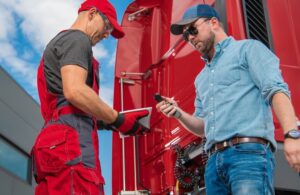Modernizing Your Driver Education
This guide is designed for fleet supervisors, safety managers, and HR personnel who oversee commercial driver hiring or training under Federal Motor Carrier Safety Administration (FMCSA) regulations.
Background
As driver shortages continue to impact fleet industries, organizations are seeking methods besides the usual classroom-based CDL training and licensure model to ease and speed the training process. Any changes must not sacrifice safety or compliance and must meet Entry-Level Driver Training (ELDT) standards. As such, many employers are weighing e-learning vs classroom CDL training. This report explores how online, self-paced CDL training can accelerate the licensure process, cut costs, and increase accessibility while maintaining compliance.
Why It Pays to Modernize CDL Training
- Faster Time to License
Online CDL theory programs allow employees to train on their own schedule, often completing required coursework in 7–10 days, compared with 3–5 weeks in a traditional classroom setting. In some cases, this allows current employees the option to continue working in their departments while schooling on their time to become drivers. When paired with locally scheduled behind-the-wheel training, this hybrid approach can cut onboarding time in half.
- Lower Training Costs
Smart Trucking (2023) reported that self-paced online programs typically cost $1,500–$3,000, versus $5,000–$10,000 for traditional schools. The savings don’t end there, as companies also save on travel, lodging, and downtime. For internal candidates, these savings compound quickly.
- Higher Retention and Accessibility
Employees can complete their learning modules anytime, anywhere, with mobile-friendly tools granting a huge advantage in accessibility. Additionally, this flexibility has been linked to improved pass rates and increased employee satisfaction, both of which increase retention rates.
- Integrated Compliance
The major online CDL training platforms are directly connected with FMCSA’s Training Provider Registry (TPR). This integration makes it easy to track progress, verify scores, and remain in compliance. It also eliminates the possibility of human error, as classroom formats often require manual uploads of scores. Managers can access up-to-date digital records anytime without manual paperwork, and scores are submitted in real time.
A Real-World Example
Anheuser-Busch is one of the largest brewing companies in the world, with popular brands like Budweiser and Michelob. This organization implemented an online CDL training program for employees to simplify compliance tracking and reduce administrative headaches (and costs). With thousands of employees across the United States, manual recordkeeping created a bottleneck in the training process. Switching to the online training system allowed them to automatically track test scores and report them directly to FMCSA. The company also gained instant visibility into employee progress and ensured all test scores met ELDT requirements. The result was faster onboarding, improved documentation, and reduced training record errors.
Key Takeaways
Online CDL training is reshaping the path to licensure by accelerating the process and reducing overall costs. Trainees benefit from a faster learning model, allowing them to complete coursework, pass required exams, and return to working with minimal downtime. For organizations, the shift to a virtual CDL training program yields a faster process, reductions in overall costs, improved employee retention, and regulatory compliance that is built into the system. Because of these advantages, many organizations are shifting to a hybrid model that combines self-paced driver training benefits through online learning with local driving instruction. An evaluation of trends indicates this is becoming the new industry standard.
Quick Recap:
* Online CDL training accelerates licensing and reduces costs.
* Trainees learn faster, take tests sooner, and return to the workforce with fewer delays.
* Organizations benefit from the flexibility, lower turnover, and simplified compliance.
* A hybrid model (online theory plus local driving instruction) is trending to become the new standard.
How Driving-Tests.org Can Help You
Carefully reviewing the options of online versus classroom training to assess overall organizational benefit will identify several significant advantages of online CDL training or a blend of online and classroom training. Incorporating Driving-Tests.org’s CDL Premium Corporate platform into both is advantageous to learners and especially helpful in creating a well-rounded program for your employees. It also provides these advantageous features:
- Comprehensive CDL Test Preparation: Access to up-to-date practice tests and study materials aligned with FMCSA guidelines.
- Progress Tracking and Reporting: Easily track each driver’s progress and test results to streamline record-keeping.
- Multi-User Management: Add and remove drivers or training coordinators quickly; keep everyone accountable with assigned modules.
- Engaging Mobile-Friendly Content: Drivers can study on their own schedule, reducing classroom time and improving pass rates.
By integrating proven online learning tools with practical test preparation, your drivers will be well-equipped to pass their official knowledge tests in either an in-house or third-party school setting.
References
Anheuser-Busch. (2023). CDL training success story with Vector Solutions. Vector Solutions. Retrieved from https://www.vectorsolutions.com/resources/success-stories/customer-testimonial-cdl-online-training/
Associated Training Services. (n.d.). CDL training program costs and timelines. Retrieved April 17, 2025, from https://www.truckschool.com/cdl-training/
Driving-Tests.org. (2023). CDL training for fleets: How e-learning helps reduce costs and improve compliance. Retrieved from https://driving-tests.org/cdl-premium/corporate/trucking
Federal Motor Carrier Safety Administration. (2022). Training Provider Registry requirements. U.S. Department of Transportation. Retrieved from https://tpr.fmcsa.dot.gov
Smart Trucking. (2023). Cost of CDL school and how to choose the best option. Retrieved from https://www.smart-trucking.com/truck-driving-school-cost/
U.S. Department of Transportation. (2023). Entry-Level Driver Training (ELDT) regulations. Federal Motor Carrier Safety Administration. Retrieved from https://www.fmcsa.dot.gov/registration/commercial-drivers-license/entry-level-driver-training-eldt
Vector Solutions. (2022). Modernizing CDL training with online platforms. Retrieved from https://www.vectorsolutions.com/solutions/vector-lms/online-dot-training/cdl-training/



